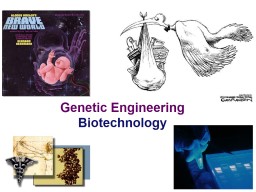

Biotechnology We have been manipulating DNA for generations Selective breeding creating new breeds of animals amp new crop plants to improve our food What is meant by being Selective The power to ID: 1018784
Download Presentation The PPT/PDF document "2006-2007 Genetic Engineering" is the property of its rightful owner. Permission is granted to download and print the materials on this web site for personal, non-commercial use only, and to display it on your personal computer provided you do not modify the materials and that you retain all copyright notices contained in the materials. By downloading content from our website, you accept the terms of this agreement.
1. 2006-2007Genetic EngineeringBiotechnology
2. We have been manipulating DNA for generations!Selective breedingcreating new breeds of animals & new crop plants to improve our food
3. What is meant by being Selective?The power to choose or pick out from among others.What music do you like?
4. Can you now define SelectiveBreeding?The process of choosing a few organisms with desirable traits to serve as the parents of the next generation.
5. Types of Selective Breeding:+Hybridization/Crossbreeding: is the process of crossing dissimilar individuals to bring together the best of both organisms.
6. Real Example of Hybridization:1872 - American horticulturist Luther Burbank (1849-1926) developed a special potato. Burbank, while trying to improve the Irish potato, developed a hybrid that was more disease resistant. He introduced the Burbank potato to Ireland to help combat the blight epidemic.Burbank’s hybrid crosses combined the disease resistance of one plant with the food-producing capacity of another.
7. Animal breeding
8. Breeding food plants“Descendants” of the wild mustardthe “Cabbage family”
9. Breeding food plantsEvolution of modern corn (right) from ancestral teosinte (left).
10. Types of Selective Breeding:Inbreeding: is the continued breeding of organisms with similar characteristicsBreeders try to maintain certain characteristics.
11. Inbreeding:Advantages:- desirable traits, like resistance to disease or strength of an organism, are collected.Disadvantages:-recessive disorders tend to increase.
12. What are some benefitsof selective breeding?Produce crops resistant to disease.Produce crops that are biggerProduce animals that have less fat.Seedless fruit!!!
13. A Brave New World
14. The code is universalSince all living organisms… use the same DNAuse the same code bookread their genes the same way
15. TACGCACATTTACGTACGCGGATGCCGCGACTATGATCACATAGACATGCTGTCAGCTCTAGTAGACTAGCTGACTCGACTAGCATGATCGATCAGCTACATGCTAGCACACYCGTACATCGATCCTGACATCGACCTGCTCGTACATGCTACTAGCTACTGACTCATGATCCAGATCACTGAAACCCTAGATCGGGTACCTATTACAGTACGATCATCCGATCAGATCATGCTAGTACATCGATCGATACTGCTACTGATCTAGCTCAATCAAACTCTTTTTGCATCATGATACTAGACTAGCTGACTGATCATGACTCTGATCCCGTAGATCGGGTACCTATTACAGTACGATCATCCGATCAGATCATGCTAGTACATCGATCGATACTGCTACTGATCTAGCTCAATCAAACTCTTTTTGCATCATGATACTAGACTAGCTGACTGATCATGACTCTGATCCCGTAGATCGGGTACCTATTACAGTACGATCATCCGATCAGATCATGCTAGTACATCGATCGATACThuman genome3.2 billion bases
16. Can we mix genes from one creature to another?YES!
17. Mixing genes for medicine…Allowing organisms to produce new proteinsbacteria producing human insulinbacteria producing human growth hormoneGenetic Engineering
18. How do we do mix genes?Genetic engineeringfind genecut DNA in both organismspaste gene from one creature into other creature’s DNAinsert new chromosome into organismorganism copies new gene as if it were its ownorganism reads gene as if it were its ownorganism produces NEW protein: Remember: we all use the same genetic code!
19. Cutting DNADNA “scissors”enzymes that cut DNArestriction enzymesused by bacteria to cut up DNA of attacking virusesEcoRI, HindIII, BamHIcut DNA at specific sitesenzymes look for specific base sequencesGTAACGAATTCACGCTTCATTGCTTAAGTGCGAAGTAACG|AATTCACGCTTCATTGCTTAA|GTGCGAA
20. Restriction enzymesCut DNA at specific sitesleave “sticky ends”GTAACG AATTCACGCTTCATTGCTTAA GTGCGAAGTAACGAATTCACGCTTCATTGCTTAAGTGCGAArestriction enzyme cut siterestriction enzyme cut site
21. Sticky endsCut other DNA with same enzymesleave “sticky ends” on bothcan glue DNA together at “sticky ends”GTAACG AATTCACGCTTCATTGCTTAA GTGCGAAgene you wantGGACCTG AATTCCGGATACCTGGACTTAA GGCCTATchromosome want to add gene toGGACCTG AATTCACGCTTCCTGGACTTAA GTGCGAAcombinedDNA
22. Sticky ends help glue genes togetherTTGTAACGAATTCTACGAATGGTTACATCGCCGAATTCACGCTTAACATTGCTTAAGATGCTTACCAATGTAGCGGCTTAAGTGCGAAgene you wantcut sitescut sitesAATGGTTACTTGTAACG AATTCTACGATCGCCGATTCAACGCTTTTACCAATGAACATTGCTTAA GATGCTAGCGGCTAAGTTGCGAAchromosome want to add gene tocut sitesAATTCTACGAATGGTTACATCGCCG GATGCTTACCAATGTAGCGGCTTAAisolated genesticky endschromosome with new gene addedTAACGAATTCTACGAATGGTTACATCGCCGAATTCTACGATC CATTGCTTAAGATGCTTACCAATGTAGCGGCTTAAGATGCTAGCsticky ends stick togetherDNA ligase joins the strandsRecombinant DNA molecule
23. Why mix genes together?TAACGAATTCTACGAATGGTTACATCGCCGAATTCTACGATC CATTGCTTAAGATGCTTACCAATGTAGCGGCTTAAGATGCTAGCGene produces protein in different organism or different individualaaaaaaaaaaaaaaaaaaaa“new” protein from organismex: human insulin from bacteriahuman insulin gene in bacteriabacteriahuman insulinHow can bacteria read human DNA?
24. Uses of genetic engineeringGenetically modified organisms (GMO)enabling plants to produce new proteinsProtect crops from insects: BT corn corn produces a bacterial toxin that kills corn borer (caterpillar pest of corn)Extend growing season: fishberries strawberries with an anti-freezing gene from flounderImprove quality of food: golden rice rice producing vitamin A improves nutritional value
25. Bacteria Bacteria are great! one-celled organismsreproduce by mitosiseasy to grow, fast to growgeneration every ~20 minutes
26. Bacterial DNA Single circular chromosomeonly one copy = haploidno nucleusOther DNA = plasmids!bacteriachromosomeplasmids
27. There’s more…Plasmidssmall extra circles of DNAcarry extra genes that bacteria can usecan be swapped between bacteriabacterial sex!!rapid evolution = antibiotic resistancecan be picked up from environment
28. How can plasmids help us?A way to get genes into bacteria easilyinsert new gene into plasmidinsert plasmid into bacteria = vectorbacteria now expresses new genebacteria make new protein+transformedbacteriagene fromother organismplasmidcut DNArecombinantplasmidvectorglue DNA
29. Grow bacteria…make moregrowbacteriaharvest (purify)proteintransformedbacteriaplasmidgene fromother organism+recombinantplasmidvector
30. Applications of biotechnology
31. Scientists can also genetically alter foods:Genetically modified foodscan be engineered to increase their content of vitamins.
32. Take a Look!!!
33. Green Glowing PigsIn daylight, their eyes and skin are green-tingedWhen lit up in the dark, the pigs glow green
34.
35. How do Scientists Clone Organisms?
36. What is a Clone?A clone is an organism that is genetically identical to the organism from which it was produced.Exact Genetic Copy
37. Do the cells of our body makeexact copies of themselves? Yes.When?GrowthRepairMitosis
38. Cloning vs. Asexual ReproductionCloning is a techniquethat accomplishes thesame end result as__________reproduction.What is the end result?The production of offspring with identical genetic information as the parent.asexual
39. How is this done?
40. Steps of Cloning: When the baby is born, it will have the same genetic information as the donor.The egg cell with the new nucleus is placed inside the womb (uterus).The nucleus of the donor somatic cell is placed inside the egg cell.The nucleus of a ‘somatic’ cell from a donor is removed. (keep the nucleus)The nucleus from an egg cell is removed. (Discard the nucleus)
41. Why Clone?Clone Stem CellsClone OrgansRevive endangered speciesReproducing a deceased petClone humans??
42. 2006-2007I’m a very special pig!Got any Questions?